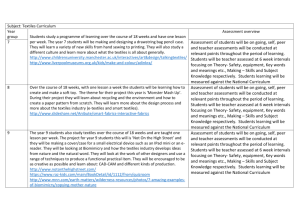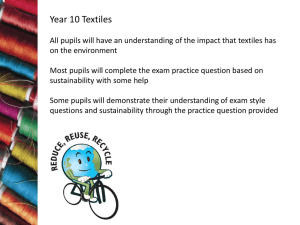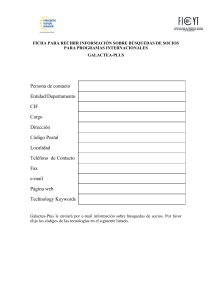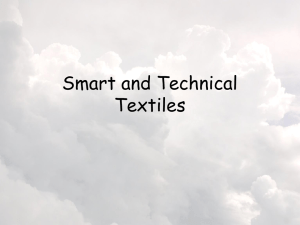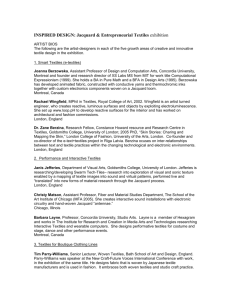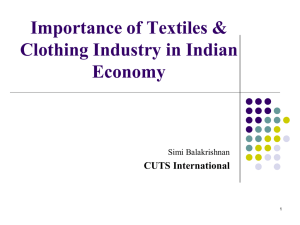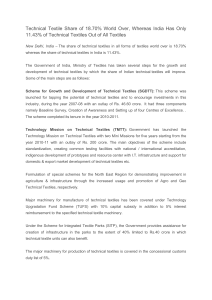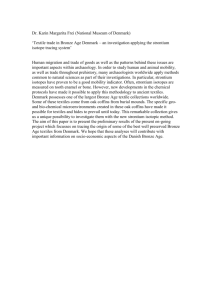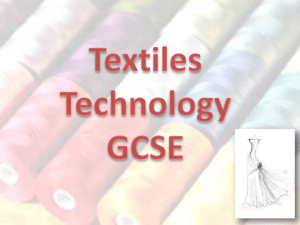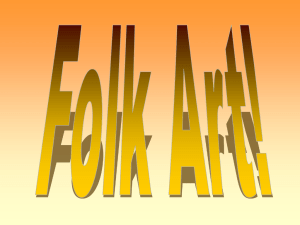TPALessonPlanHKWMCCLUNG
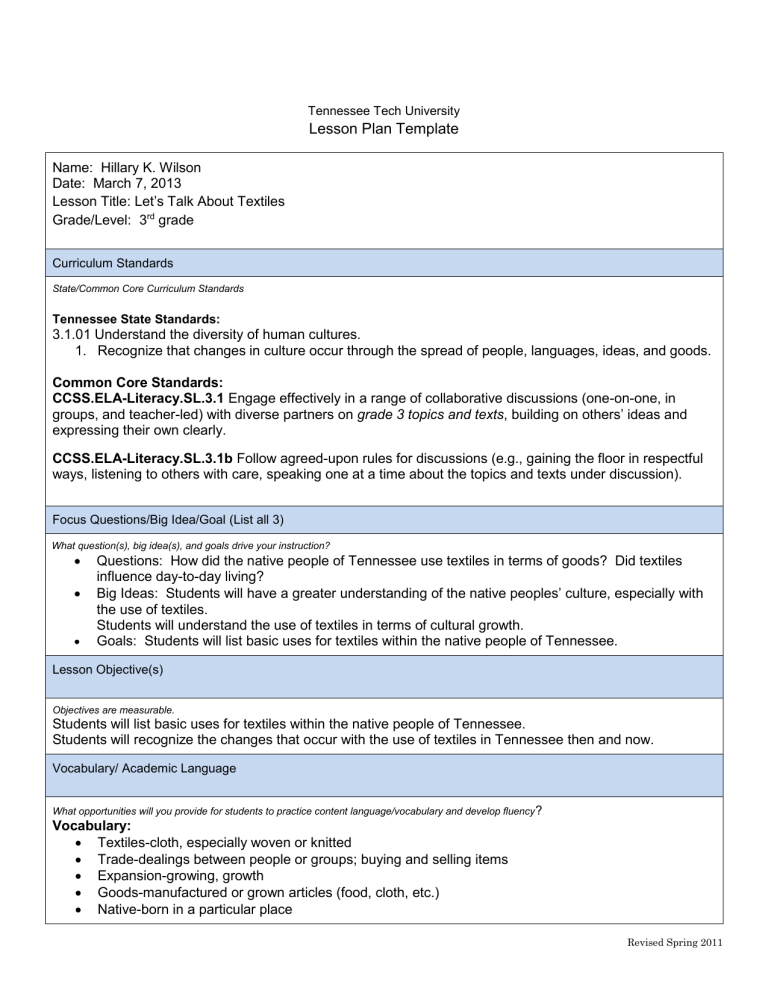
Tennessee Tech University
Lesson Plan Template
Name: Hillary K. Wilson
Date: March 7, 2013
Lesson Title: Let’s Talk About Textiles
Grade/Level: 3 rd grade
Curriculum Standards
State/Common Core Curriculum Standards
Tennessee State Standards:
3.1.01 Understand the diversity of human cultures.
1. Recognize that changes in culture occur through the spread of people, languages, ideas, and goods.
Common Core Standards:
CCSS.ELA-Literacy.SL.3.1 Engage effectively in a range of collaborative discussions (one-on-one, in groups, and teacher-led) with diverse partners on grade 3 topics and texts , building on others’ ideas and expressing their own clearly.
CCSS.ELA-Literacy.SL.3.1b
Follow agreed-upon rules for discussions (e.g., gaining the floor in respectful ways, listening to others with care, speaking one at a time about the topics and texts under discussion).
Focus Questions/Big Idea/Goal (List all 3)
What question(s), big idea(s), and goals drive your instruction?
Questions: How did the native people of Tennessee use textiles in terms of goods? Did textiles influence day-to-day living?
Big Ideas: Students will have a greater understanding of the native peoples’ culture, especially with the use of textiles.
Students will understand the use of textiles in terms of cultural growth.
Goals: Students will list basic uses for textiles within the native people of Tennessee.
Lesson Objective(s)
Objectives are measurable.
Students will list basic uses for textiles within the native people of Tennessee.
Students will recognize the changes that occur with the use of textiles in Tennessee then and now.
Vocabulary/ Academic Language
What opportunities will you provide for students to practice content language/vocabulary and develop fluency ?
Vocabulary:
Textiles-cloth, especially woven or knitted
Trade-dealings between people or groups; buying and selling items
Expansion-growing, growth
Goods-manufactured or grown articles (food, cloth, etc.)
Native-born in a particular place
Revised Spring 2011
Culture- the customary beliefs, social forms, and material traits of a racial, religious, or social group
Academic Language:
Semantic Map
Material/Resources
What do you need for this lesson?
Picture of the woven cloth from the McClung Museum
The Very First Americans by Cara Ashrose
Paper
Scissors
Semantic Maps (Pre-printed by the teacher)
Examples of textiles (items previously located in classroom, clothes, curtains etc.)
Native American Tribal Music (http://www.youtube.com/watch?v=0WNLLNxURt4)
Assessment/Evaluation
Formative: How will students demonstrate understanding of lesson objective(s)? How will you monitor and/or give feedback?
Students will demonstrate understanding by the class discussions lead by the teacher.
Summative: What evidence will you collect and how will it document student learning/mastery of lesson objective(s)
The teacher will collect each child’s semantic maps. Collectively, the class will fill in one bubble; however, the students will fill in the other bubbles individually.
Instruction
(Include a suggested time for each major activity)
List Questions for higher order thinking
These cannot be answered by yes or no.
(Ide ntify Bloom’s Level of Thinking)
Set/Motivator: How will you engage student interest in the content of the lesson? Use knowledge of students’ academic, social, and cultural characteristics.
The teacher will introduce the lesson to the children by playing Native
American Tribal music found on youtube.
(http://www.youtube.com/watch?v=0WNLLNxURt4)
The teacher will show the class a picture of a woven cloth found at the McClung Museum as an example of a textile. The teacher will explain this is a replica, and not an original primary source.
Time: 8 minutes
Level 4: Analyzing
-What instruments do you hear in the music?
-Do you know anything previously about Native
Americans?
-What do you see in this woven cloth?
-How do you think this was woven?
-What resources did they use to weave this cloth?
Instructional Procedures/Learning Tasks : Provide specific resources/details of lesson content and delivery.
The teacher will conduct a short discussion on the Native American people of Tennessee, and the United States in general. The teacher will introduce the vocabulary words orally, giving examples of each.
The teacher will describe “textiles.” The students will find examples of textiles in the room. To assess prior knowledge, the children will provide feedback to the teacher’s questions based upon their prior
Level 1: Knowledge
(Remembering)
-In what ways did Native
American people use textiles?
-What do you see on this page that incorporates the use of textiles?
Revised Spring 2011
knowledge.
The teacher will read aloud the book, The Very First Americans by
Cara Ashrose. The students will discuss the textiles and weaves seen or mentioned in the book. The teacher will write down ideas on the board as the children mention. The teacher will ask the children questions based on Bloom’s Taxonomy.
The students will create a version of the woven cloth from the museum. This will be made with printer paper and scissors.
Time: 35 minutes
Closure: Verbalize or demonstrate learning or skill one more time. May state future learning.
The students will fill out a semantic map previously printed by the teacher. The semantic map is attached.
Time: 15 minutes
Level 6: Creating
-Why have we created a semantic map?
-What is the benefit of this semantic map?
-What has this semantic map taught us?
Adaptations to Meet Individual Needs: How will you adapt the instruction to meet the needs of individual students? Include -
ELL?; SPED?; Gardner’s Learning Styles - Name and specify what happens in the lesson that uses each learning style listed; Other individual needs of the students/class you are teaching?
Management/Safety Issues: Are there any management and/or safety issues that need to be considered when teaching this lesson?
The children will be using scissors. The scissors should be made for child use. The teacher should walk around the room monitoring scissor usage.
Standard classroom management procedures should be in effect.
Rationale/Theoretical Reasoning:
This lesson appeals to visual, tactile, and musical learners. The music in the introduction will provide stimulation for musical learners. The picture from the museum will be an advantage for visual learners. Tactile learners will benefit from the semantic map and the creation of the woven cloth. The use of the picture book will appeal to auditory and visual learners, which encompasses Gardner’s
Multiple Intelligences. This will allows higher-level thinking prompted through the use of visuals. In the class discussion, the students will be given the opportunity to reflect on their ideas through reciprocal teaching. This will give both the teacher and the learner proper time to recall and reflect recent learning and knowledge. This lesson involves modeling and scaffolding, which is important in terms of Vygotsky’s research on the Zone of Proximal Development.
References: List the reference used in this lesson
Ashrose, Cara. (1993). New York, NY: Reading Railroad.
Native American Music. YouTube.com. Retrieved March 5, 2013 from http://www.youtube.com/watch?v=0WNLLNxURt4.
Reflections/Future Modifications: To what extent did the class learn what you intended them to learn? What will be your next steps instructionally? What did you learn about your students as learners? What have you learned about yourself as a teacher?
Revised Spring 2011
Revised Spring 2011

